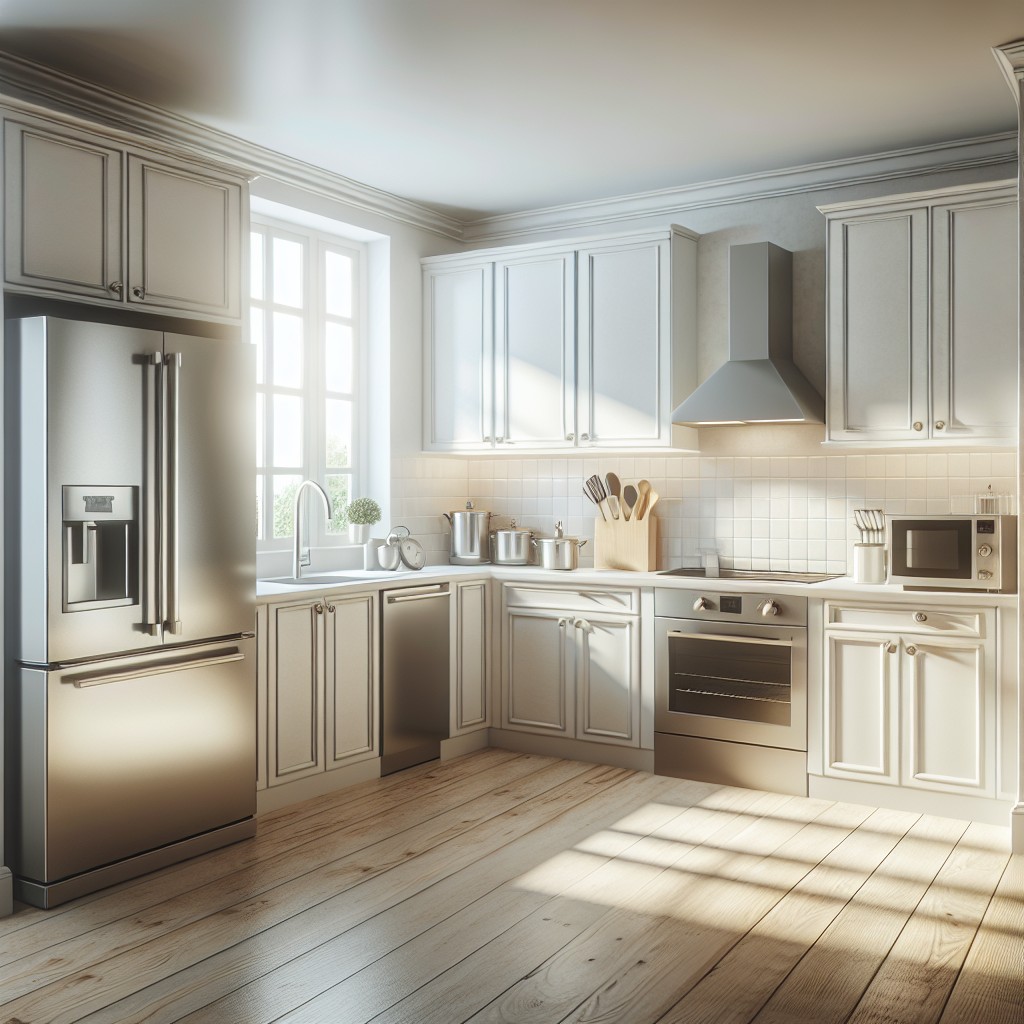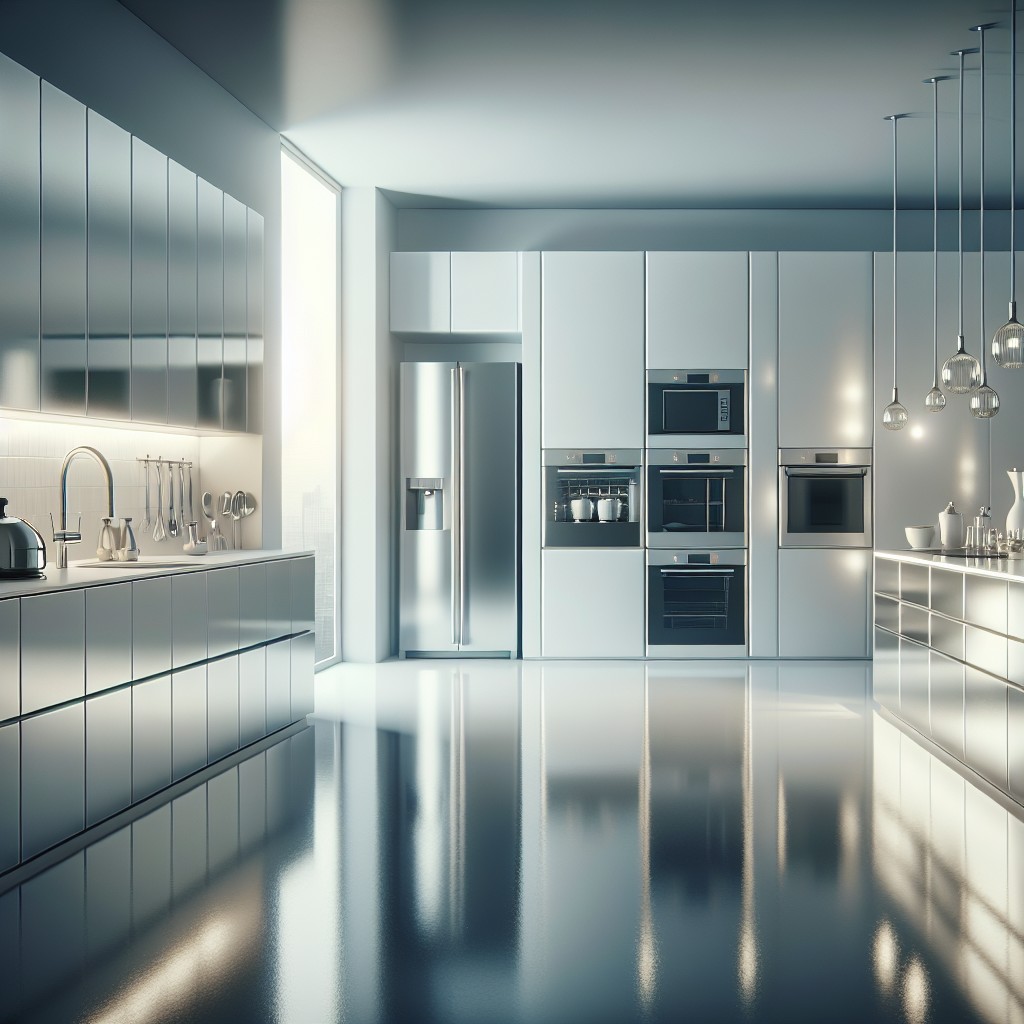Last updated on
Stainless steel appliances stand out when paired with the right color cabinets because it sets the tone for a modern, sleek, and stylish kitchen aesthetic.
Key takeaways:
- White cabinets are versatile, market-friendly, and easy to maintain.
- Gray cabinets offer versatility, balance, and monochromatic appeal.
- Dark cabinets create a striking contrast with stainless steel appliances.
- Blue cabinets add vibrancy and work with various kitchen styles.
- Two-tone cabinets provide depth and a unique aesthetic.
What's Inside
Most Popular Color to Pair With Stainless Steel Appliances in 2022

Stainless steel appliances offer a modern, sophisticated look that pairs well with a variety of cabinet colors. One of the trends in the past year has leaned towards the warmer end of the spectrum. While white remains a favorite for its crisp, clean complement to the metallic sheen, warmer tones of white, like cream or off-white, have risen in popularity. They add a touch of warmth to the kitchen without overwhelming the sleek appeal of stainless steel.
Natural wood tones, too, have made a comeback, lending a cozy, organic feel to the kitchen space. They harmonize with the coolness of the appliances, creating a balanced and inviting environment. For a bold statement, navy and deep green cabinets have emerged as go-to choices, offering depth and character to the kitchen palette.
When picking out the perfect hue, consider the size of the space and the amount of natural light—lighter tones can make small spaces appear larger, while darker colors can provide a dramatic flair to a well-lit, spacious kitchen. Keep in mind the overall aesthetic you aim to achieve, whether it’s a clean, minimalistic look, or a richer, more opulent vibe.
White Cabinets for a Timeless Look

The clean lines and crisp feel of white cabinets serve as the perfect backdrop for the metallic sheen of stainless steel appliances. They provide a classic foundation that’s versatile:
1. Versatility: Whether your taste leans towards a modern minimalist kitchen or a cozy farmhouse aesthetic, white cabinetry can accommodate a broad range of styles.
2. Space Perception: They are excellent for making small kitchens appear larger by reflecting light, enhancing the brightness of the space.
3. Market Appeal: White is market-friendly, often appealing to potential homebuyers for its neutrality and clean look.
4. Accessorizing: With white as a neutral base, it’s easy to switch up the look of your kitchen with colorful accessories or to change the wall color.
5. Maintenance and Upkeep: A consideration for white cabinets is visibility of dirt and smudges, which may require more frequent cleaning compared to darker colors. However, this also means that dirt never goes unnoticed, ensuring a consistently clean kitchen environment.
Gray Cabinets for Sleek Styling
Opting for gray cabinets creates an elegant and contemporary look that harmonizes effortlessly with stainless steel appliances. Here are some key points to consider when pairing them together:
- Versatility: Gray’s wide range of shades, from light heather to deep charcoal, offers versatility. A lighter gray can brighten a space, while darker tones provide a dramatic effect.
- Monochromatic appeal: Similar undertones in gray cabinetry and stainless steel create a cohesive aesthetic, ensuring a smooth blend between appliances and furnishings.
- Balance: Gray’s neutrality helps balance the colder appearance of stainless steel, imparting warmth without overwhelming the kitchen’s palette.
- Texture and materials: Incorporate different textures, such as a matte finish on cabinets, to add depth and contrast to the metallic sheen of the appliances.
- Accent colors: Gray serves as an excellent backdrop for adding splashes of color through accessories or decor, allowing for flexibility in evolving kitchen styles.
By being mindful of these details, gray cabinets can anchor your kitchen’s design around your stainless steel appliances, resulting in a stylish and sophisticated space.
Dark Cabinets to Contrast Stainless Steel Shine
Embracing the stark contrast between dark cabinetry and stainless steel appliances can create a striking visual impact in your kitchen. The glossy finish of the metal appliances offsets the depth and solidity of dark woods or matte finishes on the cabinets.
- Rich hues like espresso, black, or navy provide a dramatic backdrop that allows stainless steel appliances to stand out.
- Considering texture can add depth; opt for cabinets with a wood grain or a brushed finish for a more dynamic interplay with the sleekness of metal.
- To prevent the space from feeling too dark, incorporate under-cabinet lighting or strategically place light fixtures to enhance the reflective surfaces of the appliances.
- Integrating handles and knobs in a brushed stainless steel finish on the cabinets provides a cohesive look that bridges the elements together.
- When selecting dark cabinet colors, factor in your kitchen’s natural light to ensure the space maintains a balanced and inviting ambiance.
Blue Cabinets to Add a Pop of Color
Introducing blue cabinetry into a kitchen with stainless steel appliances makes for a vibrant and modern aesthetic. The cool tones of blue can range from soft powder blues to rich navy hues, creating either a serene backdrop or a statement-making space.
- Soft blues pair well with the sleekness of stainless steel for a light, airy feel.
- Navy or royal blue cabinets serve as a striking contrast that still harmonizes due to the neutrality of the appliances.
- Blue cabinets offer flexibility in design, working with nautical, farmhouse, or contemporary styles.
- Pairing with lighter countertops can help maintain a balanced and inviting atmosphere.
- Accent with brushed nickel or chrome hardware to tie the stainless steel elements together seamlessly.
Consider the size of the kitchen and the amount of natural light when selecting the shade of blue to ensure the space remains open and welcoming.
Two-Tone Cabinets for a Unique Aesthetic
Embracing two-tone cabinets provides an opportunity to blend functionality with personal style. The upper cabinets could be finished in a lighter hue such as cream or soft gray, enhancing spaciousness and reflecting light. Meanwhile, lower cabinets in a deep navy or forest green ground the space and conceal potential scuffs and marks. This approach not only lends visual interest and depth to the kitchen, but also allows for a playful interaction with the sleekness of stainless steel appliances.
When implementing a two-toned look, consider the balance and transition between the two colors. A common strategy is to use the darker color on bottom to help anchor the space. For those concerned about the resale value, sticking with neutral tones is advisable, ensuring that the kitchen appeals to a wider audience. Remember, the key is to harmonize the cabinets with the appliances, creating a cohesive and inviting kitchen environment.
The Role of Countertops and Backsplashes in Color Coordination
When coordinating your kitchen’s palette, countertops and backsplashes are vital players. They can act as a bridge between the cabinets and stainless steel appliances or stand out as a focal point.
Complementary colors: Choose countertops and backsplashes in hues that complement the cabinets, creating a cohesive look.
Neutral tones: If your cabinets are colorful, consider neutral countertops for balance. Conversely, a neutral cabinet color allows for a bold backsplash choice.
Texture and pattern: Use these elements to add depth and interest without overwhelming the metallic finish of your appliances.
Material choice: Reflective materials like polished granite can echo the sheen of stainless steel, while matte finishes like concrete or butcher block will contrast and soften the kitchen’s feel.
Consistency in decor: Extend the color of your backsplash up to the wall or choose similar tones for the countertop to maintain a harmonious decor.
Always remember to collect samples and observe them in your kitchen’s lighting, ensuring the colors truly complement each other and your stainless steel features.
Lighting Effects On Cabinet Colors and Stainless Steel
Natural light can enhance the reflective quality of stainless steel appliances, giving your kitchen a brighter and more spacious feel. When cabinet colors are under ample daylight, they often appear lighter or more vibrant, making pastel or neutral colors a delightful choice.
Artificial lighting plays a crucial role, too. Cool white bulbs can bring out cooler tones in your cabinets, complementing the modern vibe of stainless steel. Warmer lights, on the other hand, can highlight the warmth in wood-toned or cream-colored cabinetry, creating a cozier atmosphere.
Keep in mind the direction of light as well. Direct lighting can cause glare on stainless steel surfaces, so consider placing lights strategically to minimize this effect while spotlighting your cabinets’ color and finish.
The color temperature of your bulbs can affect how cabinet color is perceived. A lower Kelvin rating implies a warmer color, which can enrich the hue of your cabinets, while a higher Kelvin rating results in a cooler light that may enhance gray or white cabinetry alongside your stainless steel appliances.
Lastly, dimmable lights give you control over ambiance. Dimming the lights can soften the room’s color palette and give stainless steel a muted elegance, perfect for evening gatherings or a quiet dinner at home.
Tips for Choosing the Right Paint Finish for Cabinets
Selecting the proper paint finish is crucial not only for aesthetic appeal but also for the longevity and maintenance of your cabinets.
Satin Finish: Ideal for kitchens due to its good cleaning ability and slight sheen which isn’t too glossy. Satin finishes hold up well to scrubbing, making it a practical choice for high-touch areas.
Semi-gloss Finish: More reflective than satin, semi-gloss resists moisture well, making it a strong contender for areas prone to mess, such as around the stove or sink. It’s easier to clean but may highlight imperfections.
Matte Finish: While stylish and contemporary, it is less suited to heavy-use areas since it doesn’t clean as easily as glossier finishes. It’s great for sections of cabinetry less likely to be touched frequently.
High-gloss Finish: Provides a bold, shiny look that reflects light and can make a kitchen feel more spacious. However, it tends to show fingerprints and smudges more readily and is usually more challenging to touch up.
The key is to balance personal style with practicality. For example, consider the ease of maintenance and the traffic your kitchen cabinets will endure when choosing the finish. Always test paint samples under different lighting conditions to see how they can change the look and feel of the color throughout the day.
FAQ
What color cabinets look good with stainless appliances?
Stainless steel appliances pair well with white or light gray cabinets for a contemporary kitchen look.
Do stainless steel appliances look good with white cabinets?
Stainless steel appliances indeed create a beautiful contrast and look good when paired with white cabinets.
Does stainless steel appliances look good with oak cabinets?
Yes, stainless steel appliances seamlessly blend with oak cabinets, especially when complemented by light tones and sleek gray accents for a visually appealing look.
How do black cabinets complement stainless steel appliances?
Black cabinets provide a bold contrast to stainless steel appliances, enhancing their sleek and modern look.
Can grey cabinets enhance the look of stainless steel appliances?
Yes, grey cabinets can enhance the look of stainless steel appliances by providing a sleek, contemporary contrast.
What effect do espresso cabinets have when paired with stainless steel appliances?
Espresso cabinets, when paired with stainless steel appliances, create a sleek and modern aesthetic in the kitchen.




